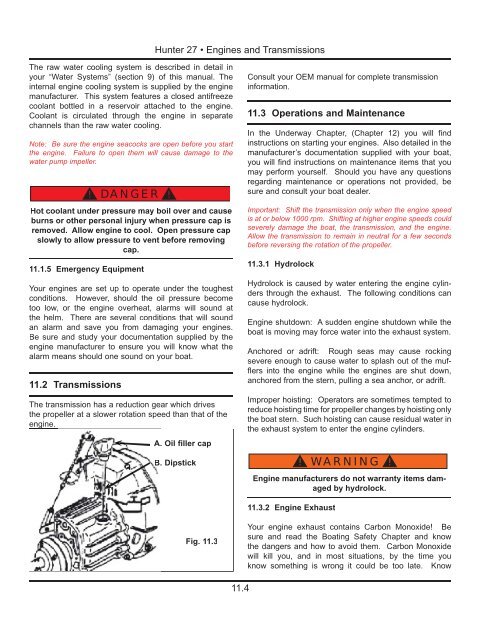27 Operator's Manual.. - Marlow-Hunter, LLC
27 Operator's Manual.. - Marlow-Hunter, LLC
27 Operator's Manual.. - Marlow-Hunter, LLC
You also want an ePaper? Increase the reach of your titles
YUMPU automatically turns print PDFs into web optimized ePapers that Google loves.
<strong>Hunter</strong> <strong>27</strong> • Engines and Transmissions<br />
The raw water cooling system is described in detail in<br />
your “Water Systems” (section 9) of this manual. The<br />
internal engine cooling system is supplied by the engine<br />
manufacturer. This system features a closed antifreeze<br />
coolant bottled in a reservoir attached to the engine.<br />
Coolant is circulated through the engine in separate<br />
channels than the raw water cooling.<br />
Note: Be sure the engine seacocks are open before you start<br />
the engine. Failure to open them will cause damage to the<br />
water pump impeller.<br />
! DANGER !<br />
burns or other personal injury when pressure cap is<br />
removed. Allow engine to cool. Open pressure cap<br />
slowly to allow pressure to vent before removing<br />
cap.<br />
11.1.5 Emergency Equipment<br />
Your engines are set up to operate under the toughest<br />
conditions. However, should the oil pressure become<br />
too low, or the engine overheat, alarms will sound at<br />
the helm. There are several conditions that will sound<br />
an alarm and save you from damaging your engines.<br />
Be sure and study your documentation supplied by the<br />
engine manufacturer to ensure you will know what the<br />
alarm means should one sound on your boat.<br />
11.2 Transmissions<br />
The transmission has a reduction gear which drives<br />
the propeller at a slower rotation speed than that of the<br />
engine.<br />
. Oil filler cap<br />
. Dipstick<br />
Consult your OEM manual for complete transmission<br />
information.<br />
11.3 Operations and Maintenance<br />
In the Underway Chapter, (Chapter 12) you will find<br />
instructions on starting your engines. Also detailed in the<br />
manufacturer’s documentation supplied with your boat,<br />
you will find instructions on maintenance items that you<br />
may perform yourself. Should you have any questions<br />
regarding maintenance or operations not provided, be<br />
sure and consult your boat dealer.<br />
Important: Shift the transmission only when the engine speed<br />
is at or below 1000 rpm. Shifting at higher engine speeds could<br />
severely damage the boat, the transmission, and the engine.<br />
Allow the transmission to remain in neutral for a few seconds<br />
before reversing the rotation of the propeller.<br />
11.3.1 Hydrolock<br />
Hydrolock is caused by water entering the engine cylinders<br />
through the exhaust. The following conditions can<br />
cause hydrolock.<br />
Engine shutdown: A sudden engine shutdown while the<br />
boat is moving may force water into the exhaust system.<br />
Anchored or adrift: Rough seas may cause rocking<br />
severe enough to cause water to splash out of the mufflers<br />
into the engine while the engines are shut down,<br />
anchored from the stern, pulling a sea anchor, or adrift.<br />
Improper hoisting: Operators are sometimes tempted to<br />
reduce hoisting time for propeller changes by hoisting only<br />
the boat stern. Such hoisting can cause residual water in<br />
the exhaust system to enter the engine cylinders.<br />
! WARNING !<br />
Engine manufacturers do not warranty items damaged<br />
by hydrolock.<br />
11.3.2 Engine Exhaust<br />
Fig. 11.3<br />
Your engine exhaust contains Carbon Monoxide! Be<br />
sure and read the Boating Safety Chapter and know<br />
the dangers and how to avoid them. Carbon Monoxide<br />
will kill you, and in most situations, by the time you<br />
know something is wrong it could be too late. Know<br />
11.4

















